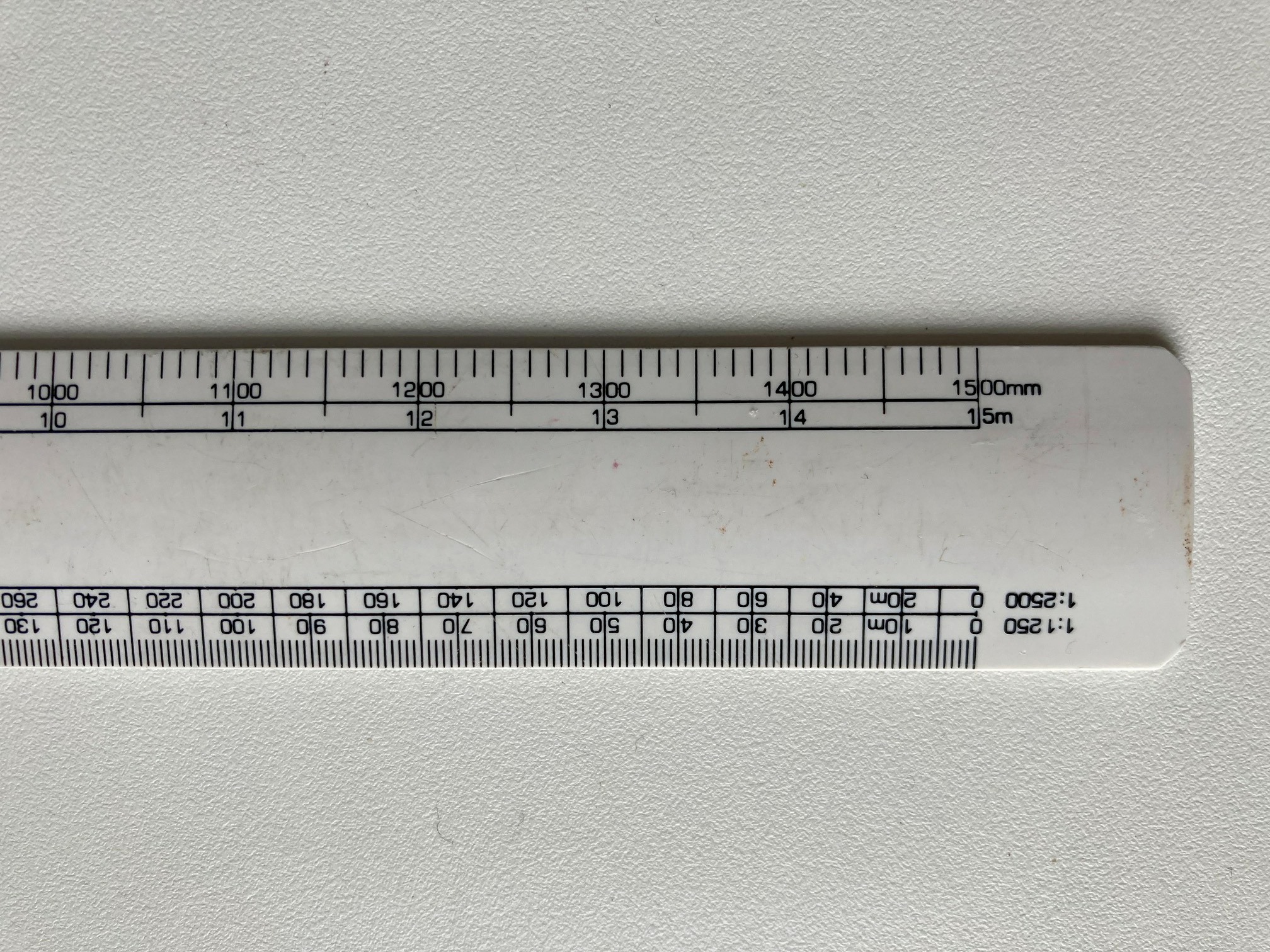Scale rule
Scale rules are used to measure distances on scale drawings and physical models.
The term scale describes the relationship between a depiction of a building, object, area of land etc compared to its actual size. Scale us usually expressed as a ratio of one unit of the represented scale compared to the actual full size dimension. So full scale is 1:1, whereas a scale on fifth of the actual size is 1:5. For more information see: Scale.
Scale drawings are used to illustrate items that it is not useful or convenient to draw at their actual size. This may be because drawing the item at full size would be unmanageable, or would not easily fit on a single sheet of paper (such as a building). For more information see: Scale drawing.
Whilst a conventional ruler allows measurement of full scale (1:1) dimensions, a scale rule also allows measurement of drawings that are not at full scale without the need for any conversion.
Scale rules typically measure full scale dimensions up to 300mm. They are generally either flat (actually a flat oval shape), similar to a conventional ruler, with 8 different scales along their four edges (2 on each edge), or a three pronged star shape (generally referred to as triangular) with 12 different scales along their 6 edges.
The scales on a four edged flat scale rule are generally: 1:1, 1:100, 1:20, 1:200, 1:5, 1:50, 1:1250 and 1:2500
The scales on a 6 edged triangular scale rule are generally: 1:1, 1:10, 1:2, 1:20, 1:5, 1:50, 1:100, 1:200, 1:500, 1:1000, 1:1250 and 1:2500. However, they may only have 6 scales, one on each edge: 1:20, 1:25, 1:50, 1:75, 1:100 and 1:125.
Scale rules can be made of plastic, wood or metal.
Scale rules should only be used for measuring. They should not be used for drawing or cutting straight lines as this can damage their edges, making accurate measurement difficult.
[edit] Related articles on Designing Buildings
- Blueprint.
- Drawing board.
- Manual drafting techniques.
- Model.
- North American Paper Sizes
- Parallel motion.
- Paper sizes.
- Perspective.
- Projections.
- Scale drawing.
- Scale.
- Symbols on architectural drawings.
- T-square.
- Technical drawing.
- Technical drawing pen sizes.
- Techniques for drawing buildings.
- Types of drawing.
Featured articles and news
Latest Build UK Building Safety Regime explainer published
Key elements in one short, now updated document.
UKGBC launch the UK Climate Resilience Roadmap
First guidance of its kind on direct climate impacts for the built environment and how it can adapt.
CLC Health, Safety and Wellbeing Strategy 2025
Launched by the Minister for Industry to look at fatalities on site, improving mental health and other issues.
One of the most impressive Victorian architects. Book review.
Common Assessment Standard now with building safety
New CAS update now includes mandatory building safety questions.
RTPI leader to become new CIOB Chief Executive Officer
Dr Victoria Hills MRTPI, FICE to take over after Caroline Gumble’s departure.
Social and affordable housing, a long term plan for delivery
The “Delivering a Decade of Renewal for Social and Affordable Housing” strategy sets out future path.
A change to adoptive architecture
Effects of global weather warming on architectural detailing, material choice and human interaction.
The proposed publicly owned and backed subsidiary of Homes England, to facilitate new homes.
How big is the problem and what can we do to mitigate the effects?
Overheating guidance and tools for building designers
A number of cool guides to help with the heat.
The UK's Modern Industrial Strategy: A 10 year plan
Previous consultation criticism, current key elements and general support with some persisting reservations.
Building Safety Regulator reforms
New roles, new staff and a new fast track service pave the way for a single construction regulator.
Architectural Technologist CPDs and Communications
CIAT CPD… and how you can do it!
Cooling centres and cool spaces
Managing extreme heat in cities by directing the public to places for heat stress relief and water sources.
Winter gardens: A brief history and warm variations
Extending the season with glass in different forms and terms.
Restoring Great Yarmouth's Winter Gardens
Transforming one of the least sustainable constructions imaginable.























